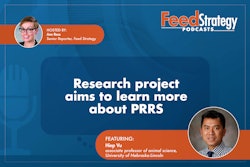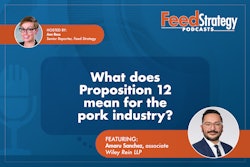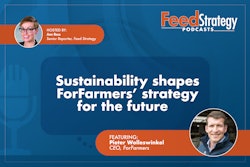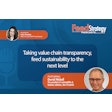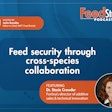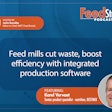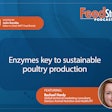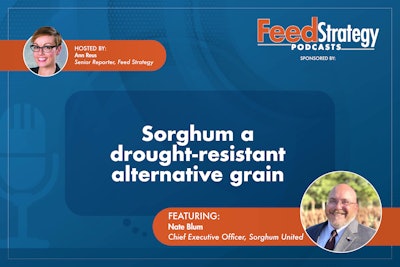
Ann Reus: Hello and welcome to the Feed Strategy podcast. I’m your host, Feed Strategy senior reporter Ann Reus.
Sorghum is a versatile crop that is known to be heat- and drought resistant and requires 30% less water than comparable grains. It is a nutritious ingredient used in animal feed and human food that is rich in iron, antioxidants and minerals.
Sorghum United is an organization that believes sorghum plays an important role in the future of agriculture and food security. It promotes the advancement of the sorghum and millet industry around the world.
Sorghum United CEO Nate Blum joins me on the podcast to talk more about sorghum and how it can be used.
Hi, Nate. Thanks for joining me on the podcast.
Nate Blum: Ann, it’s a pleasure to be with you. Thank you so much for your time.
Reus: Tell me about some of your work at Sorghum United.
Blum: Oh boy, just some of it. Well, I work at Sorghum United is actually pretty vast. Really, the space that we’re working in globally, I should say, Ann, is really the food security space, through regional food systems, addressing things like hunger and malnutrition as well as economic and environmental sustainability. Now, we do that through the lens of the promotion of sorghum and millets. Not that they are the only solution to these problems, but they do provide several solutions in conjunction with other grains. So, while we’re out there promoting sorghum and millets, that does not come at the cost of other grains like corn or wheat, rice, soybean, etc., etc. On the contrary, we say that there’s room on the plate for everybody and that cropping systems and human diets, quite frankly, can benefit from more diversity. And the inclusion of these grains can be a big part of that.
Reus: How do sorghum and millet differ from each other and how they are unique from other grains?
Blum: Well, it’s funny, I’m in Rome at the moment as we’re speaking here, and I’m here for the closing ceremony of the International Year of Millets, which was 2023, at the United Nations, FAO (Food and Agriculture Organization). But what I like to remind people is there’s actually no such thing as millets. And what I mean by that is, the millets category actually comprises dozens of different small grains, mostly in the Paceae grass family, sorghum being considered a major millet only because it’s larger, but there are several. So your listeners back in the United States would maybe more be familiar with sorghum and proso millet, then we have a bit of foxtail millet, and finger millet and some things like that as well in the Northwest. But those are the main ones that are grown there. Now, in India, there are all these different varieties are grown, and in many parts of Africa, these other varieties are grown as well.
And how they differ from other grains? I like to tell people, they ask me, “Well, what can you do with sorghum and millets,” for example. And I say, “You can do anything you do with any grain,” right? So you can make it into flour, you can you can boil it and make it just as a whole grain like you would rice, for example. Where they really differ is that they’re very drought-tolerant crops they use about, well, sorghum uses a third of the water of corn, for example, and some other millets, I think, like foxtail uses as much potential as a 10th of the water of corn. And so they make a lot of sense in arid climates or dryland conditions. But they also do really quite well under irrigation; they shouldn’t only be used in dryland conditions.
And then from a nutrition standpoint, they’re highly nutritive, and I can sure send you and any of your listeners that would like to have it, a comparison chart, the nutritive value of sorghum and millets as compared with other grants. So it makes a lot of sense that we should be kind of, I don’t want to say, remembering these grains, but we should be reviving these grains, which we used to be used quite commonly in human diets and cropping systems, but over the last 40 to 50 years, have gone kind of out of the public consciousness. So we’re trying to change that.
Reus: So I hear that sorghum is maybe less affected by climate change than other crops. Can you say more about that?
Blum: Yeah, absolutely. And like I said, so it uses about a third of the water, but also because it’s a member of the Paceae grass family, and this is how I like to explain this to students: Think about your front lawn or your back lawn in a dry year. What happens to your grass? Does it does it die? Does it turn brown? What happens? And then, of course, they’ll say, “Well, it turns brown.” OK, great. So what happens if you have a little bit of water though? “Well, turns green again.” Yes. OK. That’s because that grass went dormant. It didn’t die. And so what we see and we actually saw this in southwest Nebraska just a couple of years ago during a terrible drought there. Other crops like corn, not to pick on corn, but the they did not do well. I mean, they burned up, they died, there was nothing, right? Sorghum goes dormant, which does affect the yield, but at least there was a yield to be had, right? And so this is really important in areas, not just in Nebraska or the United States, but also, say, in Guyana, where I’m told the rice crops are failing because of lack of water and inconsistent rains and rising temperatures. I’ve been in places in Africa where entire villages are now dependent upon food aid because they can no longer grow maize. Their livestock has then also died. And, of course, India has figured this out a long time ago, in pushing for the International Year of Millets, and even prior to that, at the governmental level promoting these grains in their food systems, because there they had a terrible drought that affected their wheat and other things.
So, there’s a tremendous role for millets to play, as we talked about food security, and what that looks like in a climate that is, in many parts of the world, becoming warmer, and the rains are becoming less consistent and less reliable. Even here in Italy, there was an article that just came out last week from the University of Bologna, talking about the importance of considering sorghum, forage sorghum, in this case, for dairy cattle feed. So, the Mediterranean basin has been one of the areas that has been the most hard hit by climate change. And so here, even in Europe, we’re looking at these grains as solutions.
Reus: What are some of the nutritional aspects of sorghum for animals?
Blum: Yeah, so I’m going to point you directly to some amazing resources that are out there, rather than reinventing the wheel. I will tell you the United Sorghum Checkoff Program – which we are not affiliated with, but that is your national taxpayer funded sorghum organization – they have some excellent research and feed guides available for dairy cattle for beef cattle, swine, as well as poultry. And those are downloadable PDFs on their website. That’s where I would tell folks to go to get the best nutritional information for their animals. But there’s also just a quick Google search can find a lot of that. I’m not a trained veterinarian or nutritionist, so rather than giving you an answer, I’ll point you to the direction where you can get a good answer. How’s that sound?
 Courtesy Sorghum United
Courtesy Sorghum United
Reus: Do farmers need specialized equipment to harvest sorghum or to process it in the feed mill?
Blum: Cultivation and processing do require some modifications to equipment, in particular, because of the grain size. So, for example, our farmers in Nebraska that are growing, say, corn as well as soybean and wheat and sorghum, they’ll just have to change a few components of their harvester in order to accommodate the different crop, but that’s not so bad. The header that’s used is really the same that’s used for soybean, you just have to pick it up off the ground a little higher. So that’s really not a problem at all. So that doesn’t take very much on the cultivation side. On the processing side, a stone mill’s a stone mill, right? But there are some specialized equipment needed depending on what you’re processing it into just like any other grain. So, the answer is yes – yes and no. Now, of course, it depends on what you’re trying to do with it and what scale at which you are you’re growing and harvesting, really is what it comes down to.
Reus: Have you seen an increase of sorghum acres in the U.S. or in other countries in recent years?
Blum: Actually, yes, we have. In fact, our friends over at Sorghum Partners, I just saw that they’re telling people to get out and get their seeds locked down right away because sorghum production is set to be, I don’t know if it’s an all-time high, but is definitely going to be up this year. Prior to this role, I was the director of the Nebraska Grain Sorghum Board for four years, 2019 to 2023. And I can tell you that within that span of time, we saw an increase of acres at the rate of about 130% in Nebraska alone. Now it’s still a small grain compared to our corn and soybeans, right? But still, 130% growth is 130% growth.
We’re seeing more of it being used in parts of Africa. In fact, like I said, I was just in Kenya recently. Tanzania is another one, Uganda is another one, where governments are pushing these because they’re trying to become more food independent. And they’re just realizing that their agriculture is not keeping up with the changing climate. And then, like I said, even here in Italy, not a lot of growth, but I think it’s poised for more growth. So yeah, many parts of the world, including the Pacific nations, are really pushing these grains because of the importance that they’re seeing in their food systems, or what they represent, rather, in their food systems.
Reus: What role do you think sorghum will play in the future for global food security?
Blum: Well, we’d like to see it be part of the food basket, first of all. I mean, these ancient grains that are among the first grains that were ever grown by mankind. And for a long time, millennia, they were staple parts of many diets. But just within the last 100 years or so, around the world, really the post-colonial era, they’ve gone away in favor of just a handful of grains. And again, we like all grains, we love corn, wheat, rice, soybean, etc. But our food systems, they lack that diversity that can benefit human health and environmental benefits and impacts within cropping systems. And frankly, it takes away another market for our farmers. It’s one less crop, if it’s not being grown, it’s one less crop that farmers can have access to markets for. So, I think sorghum and millets, in particular, are going to play a very large role as part of that food basket globally, moving forward. And it’s our organization’s mission to make sure that not only do we increase the production of these grains, but we increase the opportunities for value addition in regional food systems, because that’s where everybody wins.
I grew up on a farm in Nebraska, and I can tell you the last thing I want to do is tell a farmer they need to grow something that they can’t sell. Right? So, we do a lot of work in that markets development space. We have a series of children’s books, we call them the Sorgho Squad, they’re actually on display at the United Nations FAO throughout this week for the closing ceremony of the International Year of Millets, and you can find those at SorghoSquad.com or on Amazon. So, we try to develop those markets while at the same time providing the supports for the industry globally. And that’s what we’ve really done pretty well with.
Reus: Well, thanks again for your time today, Nate.
Blum: Ann, it’s been just my pleasure. Thank you so much.
Reus: And thanks to the audience for listening. I’m Ann Reus for Feed Strategy.


